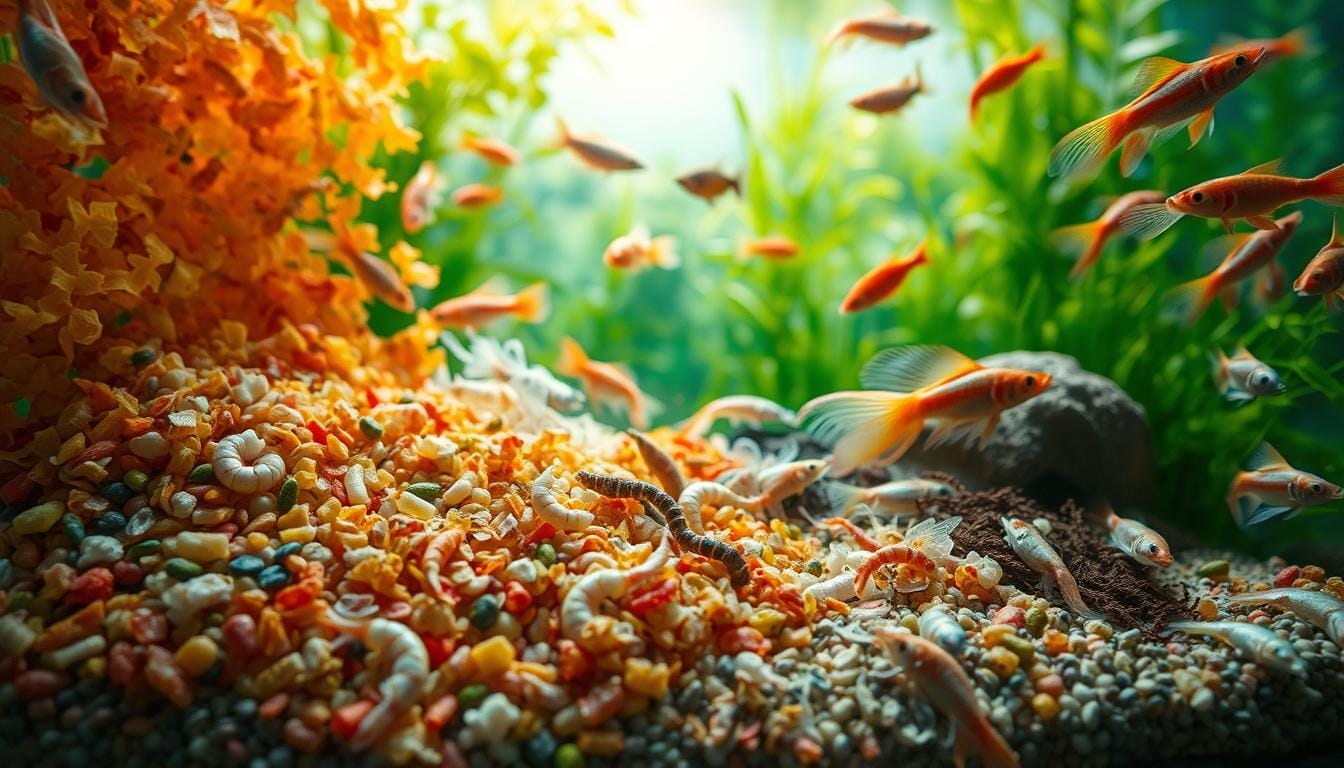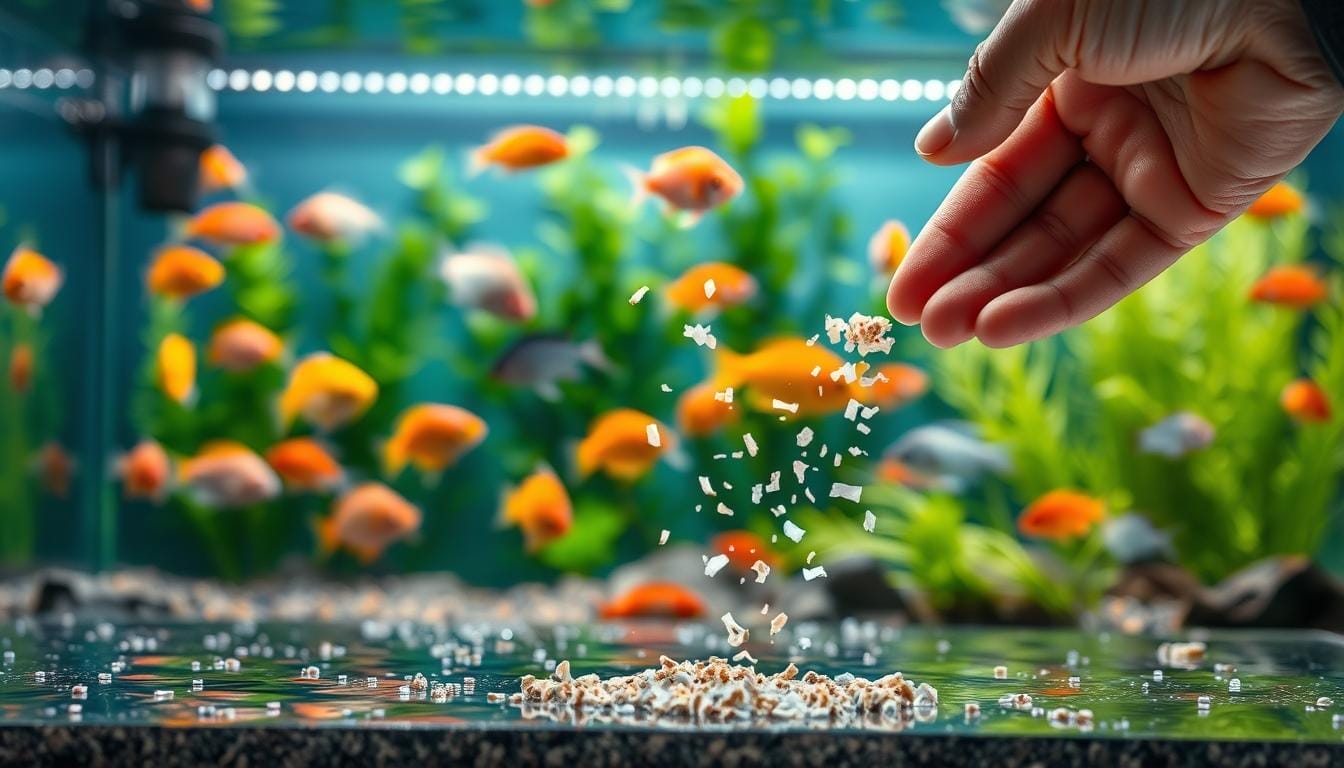
Feeding Schedule for Aquarium Fish: A Beginner’s Guide

Did you know 68% of aquarium water quality issues stem from improper meal routines? Your fish’s health depends on more than just food—it thrives on consistency that mirrors their natural habits. A well-planned routine prevents stress, boosts coloration, and keeps your aquatic friends active.
Creating the right rhythm for your tank doesn’t require a biology degree. Start by observing your fish’s behavior: Do they nibble all day or eat in bursts? Most species need small portions twice a day, but exceptions exist. We’ll show you how to adjust based on their unique needs.
Overfeeding is the #1 mistake new owners make. Leftover food decays rapidly, harming water quality. Stick to amounts they finish in 2-3 minutes. Use a timer if needed—your fish will thrive on predictability.
This guide answers your top questions, from portion sizes to vacation care. You’ll learn to balance their dietary needs with your daily life while keeping the tank ecosystem stable. Let’s build a routine that works for both of you!
Understanding Your Baby’s Nutritional Needs
Just like human infants, your fish depend on precise nutrient balances to thrive. Young fish—your underwater “babies”—require tailored diets that fuel their rapid development. Start by identifying their natural eating habits: carnivores crave protein-rich meals, herbivores need plant-based options, and omnivores benefit from mixed menus.
Essential Building Blocks for Health
Protein acts as the foundation for muscle growth and tissue repair in young fish. Fats provide energy for active swimming, while vitamins boost disease resistance. Minerals like calcium strengthen scales and bones. Look for these four components in quality fish food:
- High-quality proteins (shrimp meal, spirulina)
- Omega-rich fats (from fish oils or algae)
- Vitamin blends (A, C, and D varieties)
- Calcium sources (crushed coral supplements)
Tracking Developmental Progress
Monitor your fish’s weight and size monthly during their first year. Juveniles often double in size within months when properly nourished. Bright colors and energetic behavior signal good health. If growth slows or fins appear ragged, reassess their diet. Adult fish need less protein but still require balanced meals to maintain vitality.
Age plays a critical role—adjust food types as your fish mature. A six-month-old cichlid needs different nutrition than a three-year-old counterpart. Watch for natural cues: eager eating habits mean they’re getting what they need, while ignored food suggests necessary changes.
The Role of a Consistent Mealtime Routine
Imagine your fish swimming eagerly to the surface each day, knowing exactly when their next meal arrives. This predictable pattern does more than fill bellies—it creates a stable environment where aquatic life thrives. Consistency in meal timing helps regulate their internal clocks, much like our own need for daily rhythms.
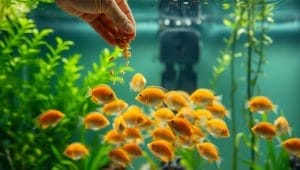
Why Structure Matters
Regular mealtimes reduce anxiety in fish, leading to brighter colors and bolder personalities. When you stick to the same times each day, they expend less energy searching for food. Instead, they channel it into growth and vibrant displays.
Structured habits also protect your tank’s ecosystem. Fish consume meals completely when fed at expected intervals, leaving fewer crumbs to decay. You’ll notice clearer water and fewer algae blooms as a result.
- Enhanced digestion: Fish metabolize food better when their bodies anticipate meals
- Behavior tracking: Spot changes in appetite instantly—a key early warning system
- Owner accountability: Prevents double-feeding during busy days
Your aquatic pals will even start recognizing you as the bringer of tasty things! Those excited darting movements when you approach the tank? That’s their way of saying “thanks” for the reliability.
Establishing a Consistent “feeding schedule”
Ever noticed how your fish gather at the same spot each day? That’s timing at work. Pair their natural instincts with your daily rhythm by selecting two fixed times you’ll never miss—like after breakfast and before bedtime. This predictability reduces stress and keeps water parameters stable.
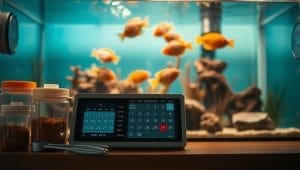
Space meals 8-12 hours apart for adult species. Nocturnal fish? Offer their main portion when lights dim. Use these strategies to sync with their biology:
- Post reminders on your fridge or phone calendar
- Set alarms during hectic workdays
- Train family members using visual guides
Start simple—morning and evening servings work for most tanks. Watch how quickly they finish meals. If food remains after three minutes, scale back portions. Adjust timing if they seem restless between meals, but allow 3-4 days between changes.
Consistency becomes second nature once you link feedings to existing habits. Pair their dinner with yours, or make post-coffee tank checks a ritual. You’ll soon spot brighter colors and livelier swimming patterns—proof your efforts pay off!
Bottle-Feeding and Breastfeeding Guidelines
Your fish communicate their needs as clearly as a crying infant—if you know what to watch for. Just like human parents learn to distinguish between hunger cries and tired whimpers, aquarium keepers must decode aquatic body language. This skill prevents overfeeding while ensuring every fish gets the nutrition they crave.
Differentiating Between Feeding Methods
Think of floating flakes as the “bottle” approach—precise portions delivered at set times. Bottom-feeding pellets or algae wafers act like “breast milk”, available for grazing species. Surface-dwelling fish often dart upward eagerly (bottle-style), while catfish and loaches forage slowly (breast-like).
- Formula users: Fish requiring specialized diets (e.g., discus)
- Free feeders: Herbivores that nibble algae throughout the day
- Hybrid eaters: Omnivores needing both approaches
Spotting True Hunger vs. Curiosity
Genuine hunger shows through repetitive surface circling or flaring gills. Opportunistic nibblers? They’ll lose interest after a bite. Watch for these signs of fullness:
- Fish swim away after initial bites
- Food sinks untouched past active swimmers
- Aggressive eaters become disinterested
Adjust portions like you’d mix formula—measure carefully and tweak based on appetite changes. Warmer water increases metabolism, requiring more frequent “meals,” while cooler temps slow digestion. Your tank’s unique needs will guide you better than any rigid plan!
Introducing Solid Foods to Your Little One
Just as parents celebrate their baby’s first bites, aquarium keepers witness exciting milestones when young fish graduate to adult diets. This transition requires careful observation and gradual changes to support healthy development. Timing matters—rush the process, and you risk digestive issues; delay it, and growth may stall.
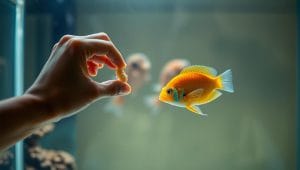
Signs Your Fish Are Ready
Watch for these clues that juveniles can handle solid foods:
- Doubled body size compared to fry stage
- Consistent exploration of tank surfaces
- Adult-like color patterns emerging
Texture Transition Strategies
Start with crumbled flakes before offering whole pellets. Over 2-3 months, mix these approaches:
- Combine brine shrimp with powdered algae
- Alternate freeze-dried daphnia and micro pellets
- Soak larger foods briefly for easier chewing
If your fish ignore new foods, try offering them during morning feedings when appetite peaks. Successful transitions show in shiny scales and energetic swimming—nature’s way of saying “you’ve got this!”
Age-Specific Feeding Milestones
Your fish’s first year is packed with growth spurts that demand tailored nutrition. Think of their development like human childhood stages—each age bracket requires unique dietary adjustments. From fragile fry to robust juveniles, their needs shift dramatically every few months.
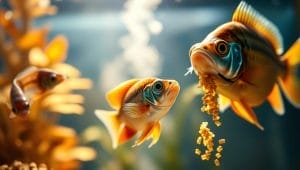
3-5 Months: Pre-Solids and Routine Building
During these formative months, young fish need bite-sized meals 4-5 times daily. Their tiny mouths thrive on:
- Powdered spirulina or crushed flakes
- Baby brine shrimp for protein boosts
- Liquid fry food for slow grazers
This phase builds eating habits. Stick to set times—consistency now prevents pickiness later.
6-7 Months: Early Solids and Modified Milk Feeds
Around six months, most species handle small pellets. Gradually mix adult food with their “milk” diet (liquid fry formulas):
- Replace one daily meal with micro pellets
- Soak foods briefly for easier digestion
- Reduce milk feeds by 25% weekly
Watch for excitement toward new textures—it signals readiness for advanced options. By seven months, they’ll likely prefer solids while maintaining occasional milk supplements.
Your careful attention during this first year sets the stage for lifelong health. Notice brighter colors and vigorous swimming? That’s your success story unfolding!
Adjusting Feeding Amounts During Growth Spurts
Your aquarium’s little ones might surprise you with sudden size jumps—here’s how to keep up. Young fish often double their weight within weeks during growth spurts, needing temporary boosts in meal sizes. Watch for frantic swimming at meal times or constantly pecking at tank surfaces—these signal it’s time to increase amounts.
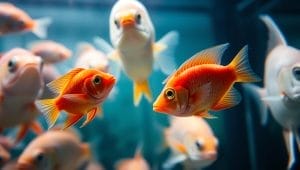
Boost portions slowly—add 10% more food every other day until they finish meals in 2 minutes. Avoid sudden jumps that could overwhelm their digestion. Healthy gain shows as proportional body shaping, not round bellies.
Most baby fish hit major milestones at 2-4 months. Warmer water temperatures accelerate metabolism, making summer months prime time for adjustments. If your guppy fry suddenly resemble adults, they’re likely in a critical growth phase.
- Track size weekly with photos against tank decorations
- Offer protein-rich snacks like daphnia between meals
- Reduce portions if food sinks uneaten
Remember: Each fish grows at its own pace. A plump cichlid baby might need 50% more food than its tankmates, while shy tetras require careful observation. Trust their behavior more than charts—active, colorful fish usually get the amounts right!
Portion Control and Measuring Ounces Accurately
Precision transforms guesswork into confidence when managing your aquarium’s meals. Think of each pinch as medicine—too little leaves fish undernourished, while excess harms water quality. Start by using a measuring spoon or aquarium-specific dispenser to track ounces per serving.
Adult fish typically need 0.1-0.3 ounces daily, split into two meals. Smaller species? Reduce portions by half. Observe their intake speed—if flakes vanish in 90 seconds, you’ve nailed the amount.
Try these pro strategies:
- Weigh food weekly with a kitchen scale for consistency
- Store pre-measured portions in labeled containers
- Adjust by 10% during growth phases or temperature shifts
Your fish’s weight directly impacts needs. A 3-inch tetra requires less than a 6-inch cichlid, even at the same age. Track their size monthly using tank decorations as reference points.
For community tanks, scatter food across multiple areas to ensure fair access. Uneaten bits after three minutes? Scoop them out immediately. This habit protects water chemistry while teaching you their ideal per day limits.
Remember: Consistency in ounces matters more than frequency. Your careful measurements create a thriving ecosystem where every fish gets what they need—nothing more, nothing less.
Integrating Family Mealtimes into the Routine
What if caring for your aquarium became a family bonding moment? Aligning your fish’s meals with your own creates shared responsibility while teaching valuable lessons. Sync their food times with breakfast and dinner—your little ones will love watching aquatic pals eat alongside them!
Creating a Positive Feeding Environment
Calm energy matters during mealtimes. Dim bright lights and ask children to avoid tapping the glass. Your fish recognize familiar faces—consistent family participation helps them feel secure. Try these stress-reducing strategies:
- Assign specific days for each member to serve meals
- Use a quiet voice near the tank during eating periods
- Store food in labeled containers to prevent mix-ups
Babies—both human and fish—thrive on predictability. A posted chart with portion sizes and times keeps everyone informed. For young children, use a small cup to measure flakes together. This hands-on approach prevents overfeeding while making care routines educational.
Watch how your aquatic family responds during shared meals. Curious tetras might approach observing toddlers, while shy catfish peek out when the room quiets. These interactions build connections between two-legged and finned family members!
Overcoming Common Feeding Challenges
Every aquarium parent faces moments when their aquatic baby refuses meals or spits out food. These hurdles test your patience but have simple fixes. Start by identifying the root cause—water temperature shifts, stress from tankmates, or texture preferences often drive eating issues.
For picky juveniles, try soaking flakes in garlic juice to entice them. Fish ignoring sinking pellets? Place food near their favorite hiding spots. Adjust portion sizes gradually—sudden changes confuse their digestion. Rotate between 2-3 food types weekly to cover nutritional gaps.
New owners often ask: “How much is too much?” Watch for these signs:
- Baby fish lingering at the surface after meals
- Half-chewed flakes accumulating in filters
- Aggressive competition during feeding times
Address these with timed feeders for consistency or divider nets during mealtimes. Your tank’s needs will evolve—stay flexible while maintaining core routines. With practice, you’ll navigate any questions and create harmony in your underwater nursery!
FAQ
How can I tell if my baby is getting enough milk?
Watch for steady weight gain, 6-8 wet diapers daily, and alertness between meals. Your pediatrician will track growth patterns during checkups to confirm healthy intake.
Is it safe to combine breast milk and formula?
Yes! Many parents use both. Work with your healthcare provider to balance ounces and maintain nutrient-rich meals while respecting your child’s hunger cues.
When should I offer solid foods for the first time?
Most infants show readiness around 6 months. Look for head control, sitting with support, and interest in your meals. Start with iron-rich purees or soft textures.
How often do growth spurts affect meal patterns?
Expect increased hunger every 2-3 months. Offer extra ounces or more frequent nursing sessions temporarily. These phases usually last 2-4 days.
What’s the best way to measure portions for bottle-fed babies?
Follow weight-based guidelines (2.5 oz per pound daily) but prioritize hunger signals. Use slow-flow nipples and stop when they turn away or relax their hands.
How can I help my baby enjoy family meals?
Include them at the table during your mealtimes, even before solids. Narrate your actions, smile, and avoid pressuring them to eat—positive associations matter most!
What if my child refuses new textures?
A> Stay calm and try again in a few days. Mix familiar flavors with new ones, and let them explore with hands. It often takes 10-15 exposures before acceptance.





